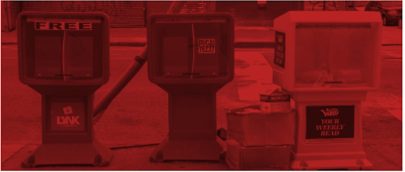FAQ: Connecticut State Advertising in Print and Digital Media
HB 5408 aims to revitalize Connecticut’s local news outlets through the strategic reallocation of state advertising revenue. This FAQ provides a comprehensive overview of the bill’s approach to supporting the press and strengthening our communities and democracy.
Local news outlets are a vital part of our communities and democracy. They inform community members about decisions that impact their lives and spark civic engagement among people closest to the issues. They are a cornerstone of democracy as we know it. But, simply put, the collapse of local news in recent decades poses a tremendous threat to the civic health of America’s cities and towns. Here in Connecticut, we have the power to reverse this decline – to restore resources and stability to the community news outlets that keep us all connected – with the passage of HB 5408, a bill to support local press through the reallocation of state advertising revenue.
HB 5408 Impact-Related Questions
Question: What does the bill do?
Answer: House Bill 5408 reallocates 15% of agency advertising budgets for Connecticut-owned local news outlets, many of whom are facing dire economic conditions. The bill makes waivers available for agencies whose advertising campaigns are focused on out-of-state for recruitment and other investments outside the state. In addition, the legislation requires state agencies to publicly report their existing print and digital advertising spending. Finally, the bill prioritizes news outlets’ editorial independence by implementing the advertising and reporting system in collaboration with an independent third party monitor within a Connecticut higher education institution.
Question: Does this bill interfere with a free market for media advertising? Is it anti-competitive against larger media outlets?
Answer: The bill only guarantees 15% of existing advertising dollars for Connecticut-owned local news. The economic and civic value these small local news outlets provide their communities far outweighs this small investment. The remaining 85% of agencies’ advertising budgets can be spent anywhere they deem appropriate, including with the largest social media companies and out-of-state-owned media. This legislation simply acknowledges the value of small local news organizations and provides a reliable source of revenue for sustaining and growing news coverage in communities that are most at risk of losing news coverage.
Question: Does this bill increase costs for the state and taxpayers?
Answer: The bill is written to explicitly use existing funds already allocated to agencies for advertising. No additional specific costs have been identified in implementing the reporting aspect of the bill in collaboration with a third party monitor. In fact, the bill enhances transparency by increasing the disclosure of the state’s spending for public review. Additionally, it will require local news outlets to provide detailed metrics to the state about advertising performance, giving state agencies better information about the value of their ad dollar.
Question: Does this bill allow the government to influence the press?
Answer: The state’s advertising budget has never been used to influence what news publishers choose to publish and this bill would have zero impact on that journalistic independence. The Connecticut state government currently spends millions of dollars from its advertising budget across multiple news outlets, many of which are owned by parent companies outside of the state. This advertising budget is typically used for awareness and public service advertising, tourism, bond sales, economic development, higher education, legal notices, and many other types of advertising – which is all needed for the state to do its work. The purpose of this bill is simply to require a certain percentage of the state’s advertising budget to be reallocated to Connecticut-based companies to support local journalism and keep those tax dollars invested in in-state publications.
Question: What is the impact of local journalism on local communities? On small businesses? On democracy?
Answer: Since 2000, there has been an 81% drop in newspaper advertising revenue. This disruption has resulted in the loss of journalism jobs and democratically vital news outlets across the country – more than 2,000 newspapers have closed since 2004, including here in Connecticut. Research shows that communities without strong print or digital news organizations often see a decrease in voter participation, an increase in misinformation, and increased political polarization.
Communities statewide benefit from strong local news in countless ways, including higher voting rates, more competitive elections, and lower taxes. In fact HB 5408 would likely benefit about 50 locally owned news outlets throughout the state. When the state better diversifies its advertising among local news outlets, agencies will reach a broader range of important audiences with critical information such as public health, transportation, and employment information. Local news is a way to connect hard-to-reach audiences to essential government resources.
Question: Does this bill disincentivize innovation in local news? Won’t news outlets be less likely to innovate if we prop up their business models.
Answer: Local news organizations in Connecticut have been innovating for decades — adding digital tools and civic outreach to better inform and engage their communities. Even for the most innovative of newsrooms, local advertising is an essential tool for revenue growth. As opposed to disincentivizing innovation, this set aside will likely increase it by giving newsrooms the revenue flexibility to grow their staffs, diversify their revenue streams and increase their community engagement, which will be good for not just the newsroom, but the wider community. We know that a strong local newsroom increases voter turnout and civic engagement, can reduce tax rates and public corruption. Moreover, the bill does not favor one kind of media over another. In addition to print publications, all Connecticut-owned news sites, whether digital-only, broadcast, or print are eligible for the set-aside.
Question: Is it appropriate for the state of Connecticut to be funding local newsrooms?
Answer: The state already places advertising in publications throughout the state, often contracting with advertising agencies to do so. This bill does not change that basic process; it simply requires the ad agencies to place 15% of each advertising contract with Connecticut-owned news outlets. In the bill, news outlets are defined as any entity that disseminates original news content to the public, “whether by print, broadcast, photographic, mechanical, electronic or any other means or medium,” and has done so for at least a year.
In a larger sense, government support for local news has a long history in the United States, going back to favorable postal rates set for printers under the Postal Act of 1792. In the 20th century, Congress began funding educational broadcasting and public broadcasting on radio and television – which they continue to do. In short, this bill is a new take on an existing idea – that public resources should support the public good of news and information that democracy requires. It is not a matter of if governments will fund news outlets, but how those news outlets are funded, whether the funding prioritizes newsrooms’ critical independence and to what degree that funding is transparent. HB 5408 meets all those criteria.
Implementation Questions
Question: How will the state identify news organizations to invest advertising dollars in?
Answer: The bill language outlines clear requirements for what qualifies an organization as a “publisher of news” and requires the organization’s principal place of business to be in CT. Based on these requirements, DAS will create guidelines around the contracting process and other implementation details. Like other cities have done, the bill allows for DAS to accept volunteer assistance from neutral third parties (such as universities) to help with creating these guidelines. You can see examples of similar legislation in New York City and Chicago.
Question: Where did the “publisher of news” definition come from?
Answer: The legislation is focused on investing state advertising dollars towards news organizations whose principal place of business is within the state. The definition of “publisher of news” as outlined in the legislation requires the entity receiving state advertising dollars to be disseminating original news content to the public for at least a year. Ths news can be disseminated through any medium such as print, broadcast, photographic, mechanical, or electronic mediums.
As the news industry has battled significant financial challenges in recent years, many papers and news sites that were previously owned locally have been bought out by larger news conglomerates. These massive corporations are able to sustain shifts in the news industry given their size, while smaller news outlets that remain locally-owned lack this outside financial backing.
Question: How many different entities within the state would meet the definition of “news publisher” as defined in the bill and would thus be eligible for ad dollars via this bill?
Answer: While we don’t currently have an exact number of news publishers that would benefit, we do have a coalition of 20+ organizations that have signed a letter in support of this bill, some of whom are local publishers who would stand to benefit from this first-of-its-kind legislation. In New York, many outlets who were previously underutilized by city agencies were able to use the advertising revenue to not only keep their doors open but invest in staffing and resources that would allow these outlets to grow, ultimately increasing their reporting scope and audience over time. This investment in local news in our state is meant to help spur growth in the local news industry through similar means.
Question: Which agencies within the state government are subject to the bill requirements?
Answer: The legislation clearly defines a “state agency” as any department, board, council, commission or other executive branch agency of state government. This amendment also specifically excludes higher education from the bill’s requirements.
Question: Are there any exceptions or ways to apply for a waiver to opt out of the requirements outlined in the bill?
Answer: Higher education institutions are excluded from the bill’s requirements and will not need to make any changes in how they allocate their state advertising budgets. Any state agencies (this includes any state departments, boards, councils, commission, or any other executive branch agency of state government) can request a waiver from the Commissioner of Administrative Services if the advertising they are procuring will require them to spend more than 50% of their total budget on out-of-state news publishers, and if the advertising is required for them to achieve the purpose of their advertising goals. The process for applying for a waiver will be outlined by the Department of Administrative Services.
Question: What will the role of a higher education partner look like in the context of this bill? How specifically will they assist in the process?
Answer: The bill language allows the Commissioner of Administrative Services to accept volunteer assistance from “institutions of higher education” or “other neutral third parties with relevant expertise”. The role of a third party will be similar to the City University of New York’s role in New York, where the university assisted in the following ways:
- Identifying local and hyperlocal news organizations to actively collaborate with agencies and departments, ultimately creating “a new, symbiotic public information and civic engagement ecosystem.”
- Familiarizing agency staffers with outlets serving specific communities and neighborhoods. These same outlets were often underutilized by state agencies in New York, as is the case for hyperlocal and local news organizations in Connecticut.
- Giving news outlets the tools and contacts they need to receive state advertising.
Question: Why did the strike-all amendment lower the required percentage so significantly? Will the bill as amended still generate a meaningful impact?
Answer: The amendment aimed to address concerns from members of the General Assembly about the dollar amount being reallocated to local news outlets, and whether those publishers would in fact have the capacity for the high number of ads. Lowering the required percentage does not water down the impact of the bill – and in fact, it takes a meaningful step toward requiring state agencies to track this spend for public transparency and awareness, which is a win in and of itself.
*Editor’s Note: The FAQ was prepared in partnership with M+R, an advocacy consulting firm, in relation to the government advertising set-aside bill.




